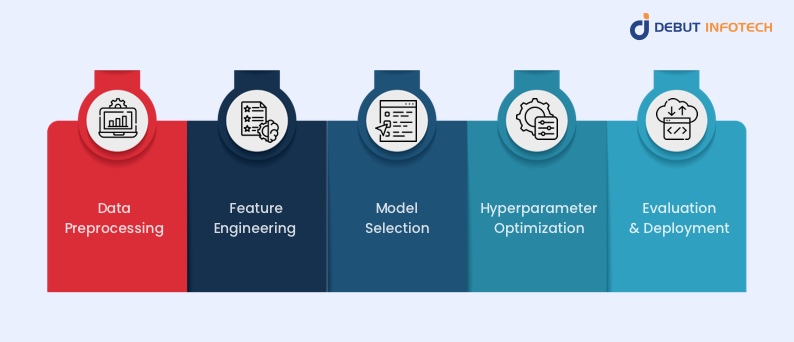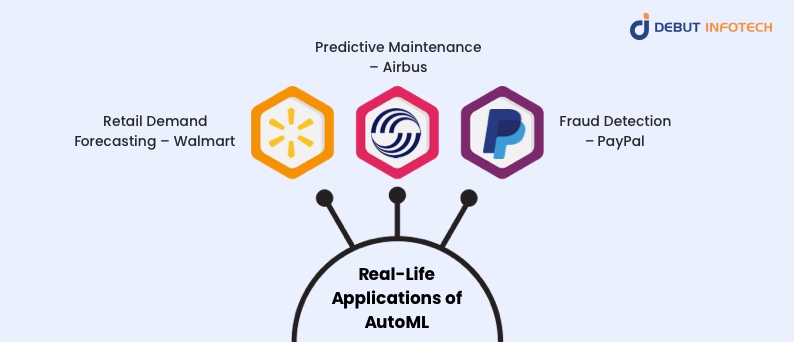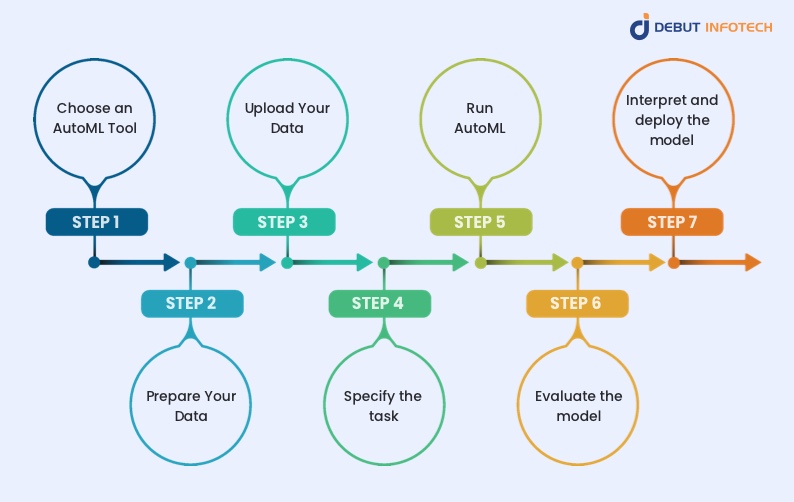Table of Contents
Home / Blog / AI/ML
AutoML Unveiled: How Automation is Redefining Machine Learning for Businesses
February 13, 2025

February 13, 2025
As machine learning (ML) has evolved, the quest for high-performing models has also made developing them more complicated, leading to the rise of solutions that not only mitigate the need for extensive tuning but also enhance performance.
To respond to this demand, AutoML automates crucial steps in the machine learning pipeline, like data preprocessing, feature engineering, model selection, and hyperparameter optimization.
The global AutoML market was valued at approximately $1.0 billion in 2023 and is projected to reach $6.4 billion by 2028, reflecting a compound annual growth rate (CAGR) of 44.6% during this period.
From finance to healthcare, organizations in nearly every industry are turning to AutoML to accelerate decision-making, enhance accuracy, and increase AI-driven applications at scale.
In this post, we’ll define AutoML, its advantages, how it works, and real-life case studies. We will also discuss the differences between AutoML and traditional machine learning, as well as AutoML techniques and how to use them.
Skip the Guesswork—Let AutoML Do the Heavy Lifting!
Tired of spending hours fine-tuning models? Our AutoML solutions take care of the complex stuff, so you can focus on making smarter decisions. Let’s automate your AI today!
What is AutoML?
Automated Machine Learning, AutoML, makes the machine learning platforms of building models, training, and deploying models much more straightforward by automating repetitive tasks related to ML model building. It eliminates the need for extensive manual coding, making machine learning more accessible to a wider audience. AutoML handles tasks such as data preprocessing, feature selection, model selection, and hyperparameter tuning. This allows businesses to integrate AI-driven solutions with minimal expertise.
How Does AutoML Work?

Here’s a step-by-step guide on how AutoML works:
1. Data Preprocessing
AutoML begins by cleaning and preparing raw data. It handles missing values, removes duplicates, normalizes numerical features, and encodes categorical variables. Automated preprocessing ensures datasets are structured correctly, improving model accuracy. This step also includes anomaly detection and outlier removal, reducing noise, and enhancing the quality of input data.
2. Feature Engineering
Feature engineering selects and transforms relevant data attributes to improve model performance. AutoML automates this process by identifying key variables, generating new features, and eliminating redundant ones. Techniques such as principal component analysis (PCA) and feature selection algorithms help refine input data, optimizing model interpretability and predictive accuracy.
3. Model Selection
AutoML evaluates multiple machine learning algorithms to identify the most effective one for a given dataset. It tests models like decision trees, support vector machines (SVMs), and deep learning architectures, ranking them based on performance metrics such as accuracy, precision, recall, and F1 score. This automation reduces manual trial-and-error selection.
4. Hyperparameter Optimization
AutoML fine-tunes model parameters to enhance performance. It automates hyperparameter tuning using techniques like Bayesian optimization, grid search, and reinforcement learning. By systematically adjusting values—such as learning rates, activation functions, and tree depths—AutoML ensures models reach optimal efficiency without requiring extensive manual intervention from data scientists.
5. Evaluation & Deployment
Once a model is trained, AutoML assesses its performance using validation datasets, cross-validation, and performance metrics. After selecting the best-performing model, it automates deployment, integrating the model into applications via APIs or cloud platforms. Continuous monitoring and retraining ensure the model adapts to new data, maintaining accuracy over time.
Benefits of AutoML for Enterprises
Here are the benefits of AutoML:
1. Cost and Time Efficiency
Using AutoML can reduce the time and cost of designing machine learning models by automating tasks, including data preprocessing, feature engineering, or model selection. This accelerates the adoption of AI across industries by allowing businesses to implement AI solutions quickly and with reduced dependence on costly data science teams.
2. Democratization of ML
AutoML cuts down the barriers to entry for machine learning through simple tools that don’t require much coding skills. Professionals from finance, healthcare, and retail can leverage AI without relying on data scientists. This broad accessibility fosters innovation, allowing more businesses to integrate AI-driven solutions into their operations.
3. Productivity Boost
AutoML automates many traditional processes that data scientists work through for long hours, thus enabling them to think about a higher level of strategy and innovation. Automating these repetitive tasks, including hyperparameter tuning and model selection, improves efficiency, allowing teams to explore a larger set of models to hone their methods before deploying AI.
4. Error Reduction
Human errors in model selection, hyperparameter tuning, and data preprocessing can negatively impact performance. A Machine learning development company leverages AutoML to systematically optimize these processes using advanced algorithms, reducing mistakes and enhancing accuracy. By removing inconsistencies caused by manual intervention, businesses can deploy more reliable AI models with improved decision-making capabilities.
AutoML vs. Traditional Machine Learning
Here’s a comparison between AutoML and traditional machine learning:
1. Expertise
Traditional machine learning requires specialized knowledge in data preprocessing, model selection, and hyperparameter tuning. Developing effective models demands expertise in programming languages like Python or R and familiarity with frameworks such as TensorFlow or PyTorch.
AutoML eliminates this barrier by automating complex tasks, making it possible for business analysts, product managers, and other non-experts to build and deploy high-quality machine learning models with minimal technical expertise.
2. Time Consumption
AutoML saves time from tedious manual processes so that data scientists can focus their time on high-level strategy and innovation. With the help of automating repetitive tasks like hyperparameter tuning and model selection, it improve efficiency. It allows teams to do more experiments with multiple models, improve their methods, and make AI go live faster.
Manually developing a machine learning model can take weeks or months due to the iterative process of selecting features, tuning hyperparameters, and optimizing performance. AutoML significantly reduces this time by automating each stage of model development. Pre-built AI algorithms and automated feature engineering enable businesses to generate models in hours or days, accelerating deployment and allowing organizations to respond faster to market demands and evolving business needs.
3. Performance
Traditional machine learning models depend on data scientists trying various algorithms and configurations that may not yield the best results.
Auto ML perfect performance systematically evaluates multiple models using advanced techniques like Bayesian optimization and Neural Architecture Search (NAS) to identify the best-performing solution. This data-driven approach often results in models that outperform those manually created, ensuring higher accuracy, better generalization, and improved real-world performance.
4. Scalability
Scaling traditional machine learning solutions can be challenging, as models often require manual reconfiguration and fine-tuning when applied to different datasets or business scenarios. AutoML, however, is designed to handle diverse use cases by automatically adjusting parameters based on data volume, complexity, and changing conditions.
With the help of machine learning consulting firms, this adaptability makes AutoML a valuable solution for enterprises managing large-scale AI deployments with minimal human intervention.
5. Cost
Hiring experienced data scientists and machine learning engineers is expensive, making AI adoption difficult for small and mid-sized businesses. Traditional ML also requires significant computing resources for model development and testing.
AutoML reduces these costs by streamlining processes, lowering the need for extensive expertise, and optimizing resource utilization. This cost efficiency allows companies of all sizes to integrate AI-driven solutions without significant financial investment.
6. Maintenance
Maintaining traditional machine learning models requires continuous monitoring, retraining, and manual intervention to ensure optimal performance. Changes in data patterns can lead to model degradation, requiring frequent updates by data scientists. AutoML automates monitoring and retraining, ensuring models remain effective over time. This self-improving mechanism reduces operational overhead and allows businesses to maintain AI solutions with minimal manual effort. A top-rated AI development company can help streamline this process.
7. Flexibility
Traditional ML frameworks require custom coding and manual adjustments when adapting models to new problems or datasets. AutoML offers a more flexible approach by automatically selecting and optimizing models for different applications. Whether it’s fraud detection, demand forecasting, or customer segmentation, AutoML platforms provide adaptable solutions that streamline AI deployment across multiple industries without extensive modifications.
Key AutoML Techniques
Here are some of the most popular AutoML techniques:
1. Bayesian Optimization
Bayesian optimization automates hyperparameter tuning by selecting the most effective configurations through probabilistic modeling. Instead of testing all possible values, it strategically explores promising options, reducing computation time. This technique enhances model performance by efficiently finding the optimal balance between accuracy and efficiency in machine learning applications.
2. Reinforcement Learning
Reinforcement learning automates decision-making by training models through trial and error. AutoML leverages this technique to optimize hyperparameters, neural architectures, and feature selection. By continuously improving based on rewards and penalties, reinforcement learning enables models to adapt dynamically, making them more effective for complex, real-world AI applications.
3. Genetic Algorithms
Genetic algorithms mimic natural selection to optimize machine learning models. AutoML uses this technique to evolve models by selecting the best-performing ones, mutating parameters, and combining features to enhance accuracy. Companies providing machine learning development techniques can leverage this evolutionary approach to identify superior solutions, reducing manual intervention in feature engineering and model selection.
4. Neural Architecture Search (NAS)
NAS automates the design of neural networks by evaluating different architectures to determine the most efficient structure. It optimizes layer configurations, activation functions, and connectivity patterns, reducing the need for manual design. This technique enables AutoML to create deep-learning models tailored to specific tasks with minimal human effort.
Real-Life Applications of AutoML

Here are real-life case studies of companies using AutoML:
1. Retail Demand Forecasting – Walmart
Walmart uses AutoML to analyze sales trends, customer behavior, and external factors like weather and economic conditions. By automating demand forecasting, the company optimizes inventory management, reduces stock shortages, and minimizes overstocking. This AI-driven approach improves supply chain efficiency and ensures products are available when and where customers need them.
2. Predictive Maintenance – Airbus
Airbus leverages AutoML to analyze sensor data from aircraft components, predicting potential failures before they occur. By automating maintenance scheduling, the company reduces unplanned downtime, enhances safety, and lowers operational costs. AI-driven predictive maintenance ensures optimal aircraft performance, extending component lifespan and improving overall efficiency in fleet management.
3. Fraud Detection – PayPal
PayPal employs AutoML to detect fraudulent transactions in real-time. By analyzing spending patterns, transaction history, and user behavior, AI-driven models identify anomalies that indicate fraud. Automated fraud detection enhances security, reduces financial losses, and provides customers with a safer payment experience without disrupting legitimate transactions.
Key components of AutoML
AutoML simplifies machine learning by automating key components that traditionally require expert intervention. These components work together to enhance accessibility and efficiency, allowing businesses and individuals to leverage machine learning without deep technical expertise. Here are the components of AutoML:
1. Data preprocessing
This serves as the foundation of machine learning pipelines. It involves cleaning and transforming raw data into a structured format suitable for analysis. Tasks such as handling missing values, removing outliers, normalizing numerical data, and encoding categorical variables are automated by AutoML, enabling efficient processing of large datasets.
2. Feature engineering and selection
Feature engineering creates new variables that highlight patterns in the data. In contrast, feature selection identifies the most relevant ones for training. AutoML systems automate both processes, reducing the need for manual adjustments and domain expertise.
3. Model selection
With a vast range of machine learning algorithms available, selecting the most effective one for a given problem can be time-consuming. AutoML evaluates multiple models, comparing their performance and automatically choosing the one best suited for the dataset, significantly streamlining the process.
4. Hyperparameter optimization
This is a crucial step in fine-tuning machine learning models for optimal performance. Hyperparameters are predefined settings that influence how a model learns, and selecting the right combination can significantly impact accuracy. AutoML streamlines this process by automatically testing multiple hyperparameter configurations, identifying the best-performing options without requiring manual intervention.
5. Model evaluation and validation
Model evaluation and validation ensure the reliability of machine learning models. Evaluation measures a model’s performance, while validation tests its ability to generalize to unseen data. AutoML simplifies these processes by generating key performance metrics, allowing users to assess accuracy and ensure the model’s predictive capability.
By automating these critical components, AutoML expands access to machine learning, making it practical for users without specialized expertise. It accelerates the development pipeline, reducing the time required to build, refine, and deploy effective machine learning models.
How to Use AutoML
Automated machine learning (AutoML) streamlines the model-building process, making machine learning accessible to a broader audience. While each AutoML platform has unique features, the fundamental steps remain consistent.

1. Choose an AutoML Tool
Various AutoML solutions are available, ranging from open-source libraries to enterprise-level platforms. Popular options include Google Cloud AutoML, Auto-sklearn, H2O’s AutoML, Microsoft’s AutoML, and AutoKeras. Your selection should align with factors such as dataset complexity, computational resources, budget, and coding proficiency.
2. Prepare Your Data
As with any machine learning application, data preprocessing is crucial. This involves cleaning inconsistencies, handling missing values, and performing necessary feature engineering to enhance model performance.
3. Upload Your Data
After preparation, the next step is feeding the data into the AutoML system. Each tool has its own method for data ingestion—some accept CSV uploads. In contrast, others require database connections or specific file formats. Ensuring compatibility at this stage prevents AI integration issues and accelerates the training process.
4. Specify the task
Whether it’s a classification, regression, or clustering problem, specifying the task clearly is essential for the tool to apply the correct algorithms. Additionally, you may need to identify the target variable—this is the output you want the model to predict, ensuring that the right goals are set for the model to achieve.
5. Run AutoML
Once started, the tool will handle feature engineering, model selection, hyperparameter tuning, and more, depending on the complexity of your data and task. Be patient, as this step can take time, especially for larger datasets or more intricate tasks.
6. Evaluate the model
Upon completion, the AutoML tool will present a trained model along with performance metrics. Understanding these metrics is important in gauging how well the model will likely generalize to unseen data.
7. Interpret and deploy the model
Many automated machine learning tools offer interpretation features that clarify how the model arrived at its predictions, which can be useful for validation and understanding. Once satisfied with the model’s performance, you can deploy it to generate predictions on new, unseen data, ensuring the model can provide real-world value.
AI That Works While You Sleep Literally
Our AutoML tools build, train, and optimize models without you lifting a finger. Get faster results, better accuracy, and zero headaches. Ready to level up your AI game?
Conclusion
AutoML is transforming machine learning by making AI more readily available, affordable, and scalable. Automated machine learning enables organizations to start using its incredible capabilities by automating time-consuming and complicated tasks without extensive knowledge.
With the push towards better decision-making and increased efficiency, AutoML becomes a potent tool in simplifying AI adoption. AutoML will give rise to more and more automation across different sectors, thanks to advances in deep learning, neural architecture search, and reinforcement learning. Its ability to reduce development time, minimize errors, and optimize performance makes it a vital component of the future AI landscape.
FAQs
AutoML automates the whole machine learning process—data prep, model selection, training, and tuning—so you don’t have to be a data scientist to build AI models. It streamlines the workflow, making it faster and easier to get accurate predictions without needing deep technical expertise.
AutoML focuses on automating machine learning tasks like training and tuning models. MLOps, on the other hand, is about managing the entire machine learning lifecycle, including deployment, monitoring, and maintenance. Think of AutoML as a tool for building models, while MLOps keeps them running smoothly in production.
It depends. Some platforms charge per use, while others offer free tiers. AutoML can actually save money by reducing the need for expensive data scientists and speeding up development time. But for large-scale projects, costs can add up, especially if you’re using cloud-based services with high processing demands.
You upload your data, define what you want to predict, and let AutoML handle the rest. It tests multiple models, fine-tunes them, and picks the best one. Some platforms let you tweak settings, but most of the heavy lifting—feature engineering, optimization, and evaluation—is handled automatically.
For quick, efficient model building, AutoML is great. It’s faster and requires less expertise. But if you need fine-tuned, highly customized models, manual training still wins. AutoML is best for general tasks, while experienced data scientists can push manual models to perform better in complex scenarios.
Talk With Our Expert
Our Latest Insights
USA
2102 Linden LN, Palatine, IL 60067
+1-703-537-5009
[email protected]
UK
Debut Infotech Pvt Ltd
7 Pound Close, Yarnton, Oxfordshire, OX51QG
+44-770-304-0079
[email protected]
Canada
Debut Infotech Pvt Ltd
326 Parkvale Drive, Kitchener, ON N2R1Y7
+1-703-537-5009
[email protected]
INDIA
Debut Infotech Pvt Ltd
C-204, Ground floor, Industrial Area Phase 8B, Mohali, PB 160055
9888402396
[email protected]




Leave a Comment